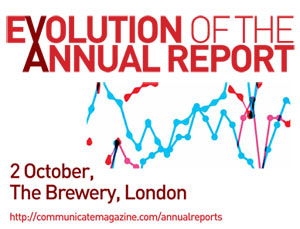I invited Richard Ketchen to write a post for us about creating annual reports. Richard advises on stakeholder communication, with a particular interest in the annual report, so I thought you’d find his suggestions helpful.
Over to you, Richard…
Common annual report mistakes, and how to avoid them
 Facts, figures and fluff. You’ll find all three in an annual report. Readers expect a little of each. For companies, though, finding the right balance is the key. Why? Because with more and more information sources available to investors and other stakeholders, the editorial quality of the annual report is increasingly important.
Facts, figures and fluff. You’ll find all three in an annual report. Readers expect a little of each. For companies, though, finding the right balance is the key. Why? Because with more and more information sources available to investors and other stakeholders, the editorial quality of the annual report is increasingly important.
Originally a periodic and soon-forgotten filing with shareholders, the report now lives 24/7 online, where it reaches an extended audience for years. So it should say what you want it to say, and be as readable online as it is in print.
With that in mind, here are a few ideas for preventing or resolving some common editorial mistakes in annual reports.
1. Removing all personality
If there’s one section that’s likely to be read by all readers, it’s the shareholder letter, especially if it’s the CEO’s letter. The first few sentences can set the tone for the entire report, while the remainder of the letter can add a distinct voice and life to an otherwise dreary dialogue. Unfortunately, by the time final copy emerges from the usual gauntlet of executive and committee reviews, it may have lost any hint of personality.
A better approach
Every CEO has a distinct “voice.” Finding it is up to the writer, whether that writer is the CEO or a ghostwriter. Keeping it is up to the CEO and the owner of the annual report. Don’t give in to the nitpickers. Make sure the shareholder letter reflects the personality of the CEO and the company, not the person hired to write it or those who review it.
2. Failing to answer the “so-what” question
Despite the growing frequency of integrating sustainability, operational and financial reporting into the annual report, there’s still a lot of “box ticking” to meet reporting requirements and not enough thinking about the relevance of some narrative. Indeed, one of the most difficult decisions that arises in annual report production is what to leave out. There’s rarely a shortage of material. Much of it, however, is of questionable value to the reader. More importantly, too much narrative makes it difficult for the reader to read and understand the report.
A better approach
Don’t assume your topic is important just because you think it is, and don’t assume everyone automatically recognizes its relevance. Always ask, so what? Be clear about establishing why your topic is important and why your readers should care.
3. Failing to target messaging
Changes in the audience for the annual report and how that audience consumes information, plus the rising focus on governance and sustainability, have brought welcome changes to corporate reporting and broadened the audience. Employees, retirees, suppliers, partners, community members, analysts and investment advisors are now part of a growing list of stakeholders interested in at least some of the report’s content. Each of these audiences is seeking different information, something that’s often overlooked.
A better approach
You can’t speak to everybody, but you must speak convincingly to your most important audiences. Consider their relationship to your company, their degree of interaction with the organization and their relationship to business strategy. Then, tailor your messaging to the audiences you value most.
4. Expecting the entire report to be read
Of course the report will be read, just not word for word. Most readers are pressed for time, so they skim and scan the copy. Plus, the front end of the report may be taken less seriously than the financials because it is often fluff-ridden. That not only discourages readers, but also adds unnecessary length.
A better approach
Focus on the needs of a reader with limited time and attention, who doesn’t have time to dwell on every word. Write and layout the content in reader-friendly formats. Use best practice in information design – and plain language – to make the report easier to read and understand. Short sentences, vertical lists, headings and subheadings (even in the shareholder letter), boxed or highlighted text, memorable and informative quotations and captions, all help. Make sure charts are easy to understand and avoid repeating that information.
5. Failing to explain the basics
You don’t need to provide a full history of your company or describe production processes or markets in exhaustive detail. But you do need to provide insight into how the company creates value. Unfortunately, not all companies provide this information, or enough of it, to help readers understand how value is created.
A better approach
Be sure your report answers the following questions: Why does the company exist? What is the vision or objective? What is the strategy? How does the company make money? Answers to questions like these are important to stakeholders, but there may be resistance among management to providing full details. You’ll improve the effectiveness of the annual report if you overcome them.
6. Not measuring effectiveness
Like many forms of communication, measuring the effectiveness of an annual report isn’t always straightforward. If your annual report really matters, though, you must set communication objectives and measure its effectiveness.
A better approach
Take stock of your annual report with a reader survey or by asking for feedback directly from key stakeholders. Benchmarking your report against peer groups or annual report awards, such as the Canadian Institute of Chartered Accountants’ corporate reporting awards, can also be effective. Whatever you do, be sure you receive honest feedback.
Fresh thinking and change are required to prevent the annual report from becoming a repository of boilerplate and historical information that is of little value to stakeholders. However, the annual report is a work-in-progress, so don’t try to change everything in one year.
Thanks, Richard!
Richard Ketchen helps clients plan, write and produce communication that informs and engages audiences. His more than 20 years of experience includes work with start-ups and multinationals in a variety of industries and on award-winning annual reports. Based in Vancouver, Canada, Richard can be reached through his website.
Lucy is Editor at Corporate Eye

